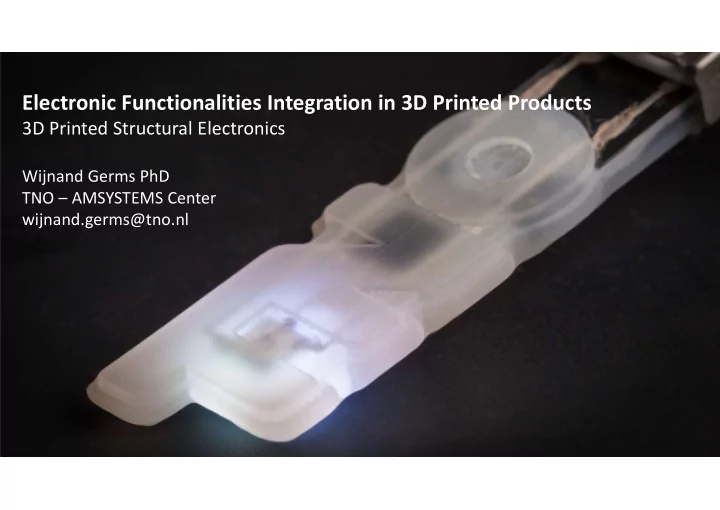

Electronic Functionalities Integration in 3D Printed Products 3D Printed Structural Electronics Wijnand Germs PhD TNO – AMSYSTEMS Center wijnand.germs@tno.nl
Alliance between TNO and TU/e-HTSC to accelerate the development of the next generation equipment for industrial additive manufacturing 3D Printed Structural Electronics, a joint activity of two TNO Centers: Holst Center – Printed Electronics AMSYSTEMS Center – equipment for industrial additive manufacturing
WHAT DOES “STRUCTURAL” MEAN Electronics embedded in the structural (load bearing) parts Replacing dumb structures such as vehicle bodies The electronics add no volume to the part
ELECTRONIC PRODUCTS IN 2018 Highly optimized manufacturing processes → Minimized $$ Assembly of housings and PCBs Drawbacks of conventional manufacturing 3D Printing High investement levels for equipment and tooling → small series / product diversity unatractive Strandardized product designs → Limited shape freedom Printed Rigid and fragmented supply chain Electronics → increasing lead times, decreasing flexibility Conventional manufacturing – tool centricity 3D Printed Electronics – data centricity
VALUE OF 3DP STRUCTURAL ELECTRONICS Electronic functionality integration in products Sensors, lighting, actuators, including data processing Reduced number of parts - reduced volume Personalization/Customization Ear buds, hearing aids, customized consumer products Low cost for low series – No product specific tooling Shorter lead times Agile manufacturing – No product specific tooling
3D PRINTED STRUCTURAL ELECTRONICS USING SLA AND SLS StereoLithography Apparatus (SLA) Selective Laser Sintering (SLS) Liquid photopolymer Polymer powder Local solidification by UV Local sintering by laser
WHY SLA FOR STRUCTURAL ELECTRONICS Water tight High resolution Microfluidics Transparant materials Surface finish Metamaterial antenna arrays Lighting Smart Connectors Waveguides
WHY SLS FOR STRUCTURAL ELECTRONICS Material strength Surface finish High temperature materials Automotive Smart Knee Ankle Foot Orthosis Orthosis
3DP STRUCTURAL ELECTRONICS DEMO Innovation Award at PMI 2016 International Conference on Polymers and Moulds Innovations Movie on: http://amsystemscenter.com/how-3d-printing-is-combined-with-printed-electronics-technologies/ Published as: Maalderink et al .,Plastics, Rubber and Composites; 2018; Vol 47, No 1, 35-41.
EMBEDDED ELECTRONICS IN FREE FORM PRODUCTS Two examples: Personalization at unit level No product specific tooling Incorporated micro-systems No PCB required Inherently encapsulated: dust/dirt proof Reducing size Free form Gear shifter knob - Electronics in small volume Personalized USB flash drive
HYB-MAN PROJECT The Hyb-Man project will develop hybrid 3D manufacturing methods to enable flexible first time right production of smart systems Processes, materials Industrialization Products & equipment materials integrated knowhow processes new products systems equipment
DEMONSTRATOR PROPERTIES Evaluation SLA material NextDent C&B Henkel WIK20489 ink on SLA substrate TGA analysis: Track widths 300 – 400 µm Non-reversible degradation starting at 250°C Track height 10 – 15 µm Glass transition temperature 95°C ~10% Cu conductivity → HDT To be done DMTA : At -40°C Complex modulus 1,6 GPa At 150°C Complex modulus 0,014 GPa Tensile test: Youngs modulus 3,5 GPa Tensile strength max 72 MPa Personalized USB drive Tensile strength break 66 MPa 7
MODULAR AM PROCESS SIMULATION UNDER DEVELOPMENT: Prediction of internal stresses and warpage Prediction of temperature field Suitable for multiple AM techniques and materials Gcode geometry input 13
24 GHZ ANTENNA DESIGN Innovation award 39 th ESA Antenna Workshop 2018 Conference Paper by Yepes et al . Together with TNO Defense, Safety and Security and TU Delft Realtime detection of small movement Autonomous driving Free 3D oriented metallic features Invisible - Intergated in car parts (bumper) Gesture Control Good agreement between simulation and measurement of single 24 GHz antenna for miniaturized FMCW radar
RUNNING PROJECTS – SMART EXOSKELETONS Movement Assisting Devices: Manufacturing of personalized Kineto- Dynamics parts and products for workers, elderly and children Selective laser sintering This project has received funding from the European Smart Knee Ankle Foot Orthosis Sit to stand orthosis Union’s Horizon 2020 research and innovation programme under grant agreement No 680754
VISION Electronic products can be designed and manufactured, with the electronic functions and the functional product shape being fully integrated, to serve the users’ need. Improved product Optimal functionality. The electronics and the mechanical design are optimal, and do not have to do concessions to each other. Cost reduction Small series production is not hindered by high investment in product specific tooling Product development process For the design process there will be a seamless connection between the mechanical design suite and the electronic design suite The resulting CAD file includes everything, and can be sent to the manufacturing line/machine. The manufacturing line/machine is a multi-technology platform and can determine itself which project step is performed in which phase of the production process.
BARRIERS AND CHALLENGES Design software ! 3D electronics design Seamless connection between electronic design and mechanical design Design rules depending on technologies used Process needs to be developed ! AMSYSTEMS/HOLST Different 3DP technologies exist Different printed electronics technologies exist. Deposition, curing, p&p. Equipment needs to be developed ! Open platform to do multitechnology/hybrid 3D manufacturing Materials need to be improved Fire retardant, temperature resistance, biocompatible, strength, heat conductivity Certification and standardization What is suitable for which application, e.g. fire retardant vs. biocompatible Product life cycle, recyclability
OUTLOOK Vertical track printing (via) Metrology & Control Improve yield Process development for different technologies, e.g. Printed electronics on SLS products Deposition technologies Sintering technologies Lighting Metamaterial antenna arrays
ACKNOWLEDGMENTS Team members at EU projects: Key partners: AMSYSTEMS: Fabien Bruning Hessel Maalderink John van der Werff Edwin van den Eijnden Mathijs de Schipper Henk Buining Jeroen Smeltink This project has received funding from the European Union’s Horizon 2020 research and innovation programme under grant agreement No 680754 Jeroen Knippeberg Joris Remmers Joris Dufils Frits Verhoeven
THANK YOU FOR YOUR ATTENTION Explore more on amsystems.com wijnand.germs@tno.nl Innovation Center by TNO and TU/e HTSC
Recommend
More recommend